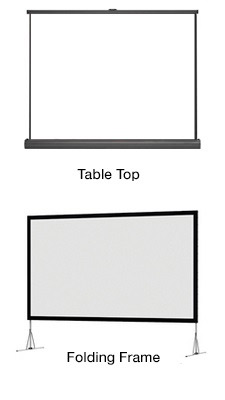ELECTRIC PROJECTOR SCREENS
Electric projector screens can be Wall Mounted, Ceiling Mounted, Floor Mounted, or Ceiling Recessed(for a concealed in-the-ceiling installation). Electric projector screens are operated by an electric motor that raises and lowers the screen via remote control or wall switch. Some Electric projector screens have a simple plug-and-play design, while others like a ceiling recessed screen, require significant installtion and most likely the assistance of an electrician.
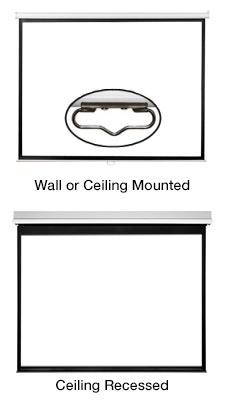
ELECTRIC PROJECTOR SCREEN SIZES
Electric projector screens tend to be larger, making them more suitable for use in auditoriums, conference rooms, classrooms and home theaters. This is due to the motorized operation of the screen handling a greater screen weight than a manual roller option. The motorized operation of an electric screen provides the user with a sleek, modern and flexible projection solution that doesn’t hinder the decor or usability of a room.
Electric projector screens are also available in a Tensioned or Non-Tensioned(standard) screen surfaces. Non-Tensioned is the standard screen surface, which hangs freely from the casing support structure. Non-Tensioned screen surfaces are slightly more prone to creases, waviness or imperfections. Tensioned screen surfaces, on the other hand, provide a flatter more uniform screen surface that is consistently stretched, resulting in less possibility of imperfections. This tensioning is usually created by a cable and tab system on electric screens that pullsTypically, tensioned screens are viewed as the highest performing screens, that maximize resolution and light reflectivity.
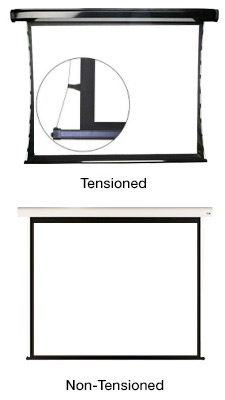
MANUAL PROJECTOR SCREENS
Manual projector screens are smaller and less expensive than Electric projector screens. Much like a standard window shade in operation, these models tend to be relatively easy to use and install. Instead of a switch or remote control, manual projector screens extend and retract manually, with the user simply pulling the screen down by hand, locking it in it’s desired height. To retract the screen, pull down the handleto release the rolling mechanism to lift the screen back into the casing.
One particularly convenient feature of many manual projector screens is a “controlled screen return” or CSR. This feature stops the projector screen from retracting into its case too quickly, preventing potential damage to the screen surface or the roller mechanism. This extends the overall life of the projector screen. Additionally, Manual projector screens, like electrics, are also available in a Tensioned screen surface or with a Ceiling Recessedcasing. Recessed manual projector screens typically come with a hand crank mechanism to lower the screen instead of a pull-down method, since the casing hides the screen in the ceiling.
*Note – Manual ceiling recessed screens typically come with a hand crank mechanism for lowering the screen, because the casing conceals itself.
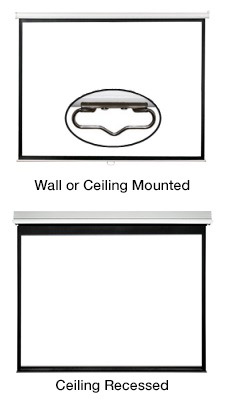
FIXED FRAME PROJECTOR SCREENS
Fixed Frame screens are among the most popular modelson the market, most commonly used for Home Theaters, Auditoriums and in any situation where a permanent wall-mounted solution is required. Fixed Frame Projector screens typically need more assembly time than others, installed in a similar manner to picture frames by hanging the screen off an anchor or bracket on the wall. This means the screen mounts on the wall more easily and with less installation and electrical work.
While flat frames are more common, Curved Fixed Frame projector screensare growing in popularity, due to the recent push in curved Televisions. These curved frames add a flare of style and ambiance to any Home Theater. The curve itself, creates the effect of enveloping the audience with its corners, wrapping the viewer in a full panoramic experience. The Curved Frame design however, offers more than just aesthetic appeal, it also optimizes light reflectivity back towards the audience.
Fixed Frame screens are also all designed with a Tensioned screen fabric, which creates the ideal flat projection surface. The perfectly flat tensioned surface maximizes the resoultion capabilities and light reflectivity of your projector, optimizing performance and creating the best possible picture quality. Many projection screen brands now manufacture HD Screen Fabrics specifically for Fixed Frames that provide the ultimate resolution, brightness and an amazing overall picture.
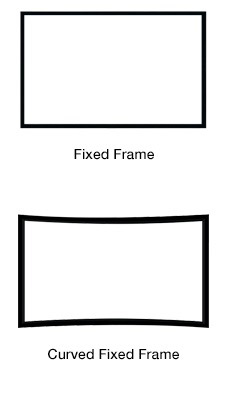
PORTABLE PROJECTOR SCREENS
If your screen is likely to be moved on a regular basis every few days, weeks or months, a Portable Screen is your best option. Portable projector screens are offered in a great range of sizes and styles. Portable screens, like Tripods usually use a pull-up screen on a free tripod stand. Historically popular in schools, because of mobility and relatively little expense, tripods are also widely used in business for traveling presentations. Floor Risingprojector screens come in Electric and Manual operation. Electrically raised or manually pulled from a weighted base/case, floor rising screens make the perfect travel companion and can remain unobtrusive when not in use. A terrific alternative to a sometimes bulkier tripod screen the lightweight floor rising projector screen requires almost zero assembly. Floor rising screens are even available with carpeted cases, designed to help the case blend in with the decor of its location.
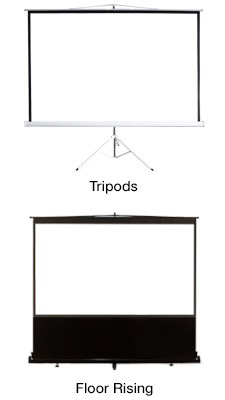
Another lightweight portable option is the Tabletop projector screen. Generally maxing out at a 50″ Diagonal size, these small ultra-portable screens are the most convenient when a large picture is either not feasible or just unecessary. The operation of Tabletop screens varies on the manufacturer; some pull up like a floor rising screen from a case, while others pull apart length ways and have stabilizing feet. Either way, this screen is ideal for any small presentation purpose!
